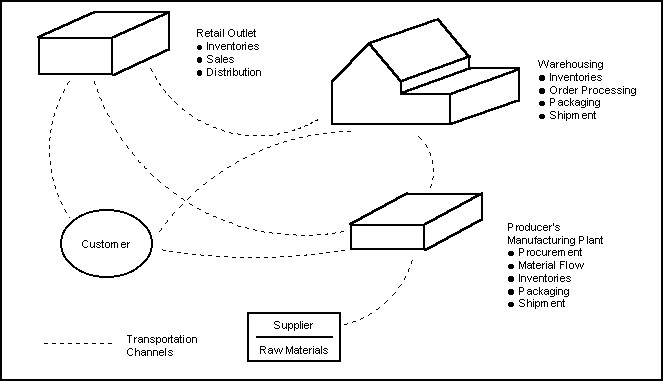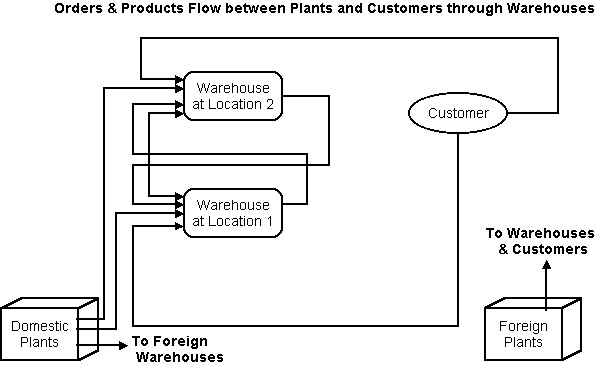
2. Simulation and Transportation with Applications to Distribution and Warehousing
[AT] Fierce competition in today’s global markets, the introduction of products with short life cycles and the heightened expectations of customers have forced enterprises to invest in and focus attention on their logistics systems. Therefore in order to study the logistics part in details we can see how simulation can be used as a tool for the design, analysis and management of logistics and transportation systems.
Current Approaches to Solving Logistics Problems
Typically, a Logistics and Transportation (L&T) system is composed of one or more terminals or hubs connected by a set of traffic lanes. Thus the networks form hub-and-spoke arrangements between origin and destination. The L&T systems utilize many resources and we can classify them as 1) Direct resources, used in physical transportation of freight from one location to another, and 2)Indirect resources, involved in sorting, storing, handling, retrieving, and consolidating at the various transit locations called terminals. Conventional L&T planning involves the development of analytical models for trip generation, trip distribution, modal split, and traffic assignment. However day by day the conventional L&T systems that are built to guarantee on time, damage free, shortage-free delivery to customers have become extremely complex and often require expensive administrative, information, and decision support systems. Hence in recent years, descriptive modeling of L&T systems has been gaining momentum in most of the companies.
Problem Domains for Simulation Modeling
L&T problems appropriate for simulation are divided into three major categories:
Accordingly, the simulation models in L&T domains are built for the following purposes:
Four major L&T problem domains are:
Distribution and Warehousing
[AB] Traditionally distribution has been viewed as a source of cost. Such a viewpoint leads to a search for improvement in operating efficiency and focus on cost reduction. Thus improving vehicle utilization, warehouse throughput times, material handling systems etc. are the various factors for concern in distribution. The rationale is that production should be planned, not in isolation, but taking into account marketing, distribution and other corporate activities. And logistics represents a move to bring distribution and associated tasks in to the main stream of corporate planning. As a result, the planning of effective distribution strategies has become a key feature of a growing number of companies.
Logistics and Distribution
The most important factor influencing the development of distribution management is the concept of logistics. One definition of logistics is " the process of strategically managing the acquisition, movement and storage of materials, parts and finished inventory (and the related information flows) through the organization and its marketing channels in such a way that current and future profitability is maximized through the cost-effective fulfillment of orders". Other definitions of logistics too embrace the manufacturing process as well as the process of procurement and distribution. The rationale is that production should be planned, not in isolation, but to take account of marketing, distribution and other corporate activities. Whatever its definition, logistics represents a move to bring distribution and associated tasks (e.g. procurement of raw materials) into the main stream of corporate planning. As a result, the planning of effective distribution strategies has become a key feature of a growing number of companies.
Logistics approach to management encourages a unified view to be taken of materials movement within a company. The integration of transport, warehousing and inventory management under the banner of distribution management is a frequent consequence of taking a logistics-based approach. In many companies, these activities remain entirely unrelated, even when the opportunity exists for an integrated approach. Logistics will often imply the need for vertical integration along the supply chain, resulting in a change in the marketing structure for distribution services. This will often imply a wholly different distribution system, since an entire link may be removed from the supply chain.
The changes in technology and consumer demand have produced volatile markets. Shortened life cycles is perhaps the most famous of them. This has created substantial problems for logistics management. Short life periods means shorter lead times, which is defined as the elapsed period of time from receipt of customer order to delivery. Also because production lead times are shortening, through the use of new technology, this in effect means transport and storage account for a greater proportion of the total procurement-to-deliver lead-time. Most of these changes in environment have served to move logistics to the center stage and in turn to focus the spotlight on customer service. Customer service is the thread that links logistics and distribution processes, because in the end, the output of the logistics system is customer service. Hence distribution and logistics must be skillfully integrated and managed in such a way as to maximize the value added through customer service while still seeking a cost advantage.
[AT] When dealing with the distribution of consumable products, the following must be determined:

The response to these questions leads to evaluation of many possible alternatives involving different mixes of consumer concentrations, retail outlets, product warehouses, transportation and handling modes, and so on. In essence, in dealing with a large network involving many variables and is dynamic in nature the application of simulation techniques, optimizing techniques, transportation models, etc are common in arriving at a preferred solution.
A simulation model of a logistics network is developed to investigate the impact of the variabilities associated with production schedules, customer demand, and transportation delays. It often incorporates a geographic map of the physical relationships among plants, terminals, warehouses, and customers. It is suggested that all these should be modeled separately and then integrated with the underlying logistics network.

A list of processes/activities modeled and represented in a logistics simulation model are:
Entities and Resources
There are two sets of entities in this area:
Data Requirements for a Warehouse Simulation Model
The input data required is:
Simulation Outputs and Responses
A list of responses or outputs that a logistics user is interested in knowing about is:
3. Simulation and Information Systems
[AT] Logistics and Information Systems
In this world of global economy, where the change of pace is unbelievable, where the customer is supposed to be the driving force, it has become more and more difficult to meet their demands. Today’s customer demands quality products, quality service and increasing value for the same or lesser price.Thus the challenge of enhancing customer satisfaction by improving logistics requires a fully integrated approach. All components of the logistics process must work as one, with each person involved having much greater awareness of the how the totality of logistics functions. Therefore the only way to enhance customer satisfaction is integration of logistics.
The integration of logistics and information technology is more than just a theory, it has a big practicality associated with it. Effective utilization of information, e-commerce, and the integration of supply chain management empower all other factors as drivers for the future. Hence in order to respond to the changes in the market in a resource effective way, the logistics person has to become a learning person and will have to identify, develop and implement new products, relationships and processes.
The role of the information technology department involved protecting the integrity of the mainframe and doling out IT resources to ‘Projects’ that had the necessary approvals and economic justifications. The decentralizing of computing power enabled functional groups to develop standalone systems that incorporated automatic data collection, mostly bar code scanning, at the front end, processing data through a computer hierarchy and reporting to a warehouse computer that required only business data such as sales orders for fulfillment. Systems of this type offered IT professionals an opportunity to work on real-time material handling systems in which the flow of the bar coded product was integrated with the flow of data through the system.As material handling systems grew more and more integrated and complex, their design and implementation was assigned to a project team, that depending on the scope of the system, might include input from:
About WMS
A WMS has distinct user classes: Operations, Information technology, Executives, Planners and Transportation managers, among others. Each needs certain information and different education levels, viewpoints and motives characterize each. The system must be up all the time to meet their information needs.
A WMS must always be tied to the vendors and consultants because when problems arise they must have contact with the right person. IT should also be involved so that they are familiar with the warehouse procedures. WMS is never a onetime activity or onetime charge. A WMS needs constant and regular improvement, depending on the business’ growth, technology changes and what competition does.As e-commerce changes how distribution centers are networked, staffed and equipped, the WMS will have to change as well. Thus its performance will show up on the record of the company annual budget.The following example illustrates the importance of the above-mentioned system:
Atlas services, the logistics arm of Veba Electronics, was facing a problem of tremendous growth which its distribution center could hardly handle. They were running at 120% of the capacity and utilizing almost every inch of space available.But after implementation of the new paperless warehouse management system and an improved software integration increased its overall productivity by about 25%, in adiition to its accuracy rate of almost 99.47%.Thus customer service has been a key to the company’s success.
[LR] But what about the role of simulation with regards to information systems?
The role of simulation on information systems will be profoundly seen as supply chain companies begin to incorporate simulation software into their packages. The benefit and potential of merging simulation and supply chain tools is important with regards to information systems since companies are now looking beyond the proverbial "four walls" and at the business operations of all their partners across the supply chain. It will be imperative for a company to be able to identify all of the interfaces present within this extended network of suppliers, distributors, and manufacturers. By identifying these interfaces, companies will be able to understand how material physically flows throughout the supply chain network. To develop these interfaces, information must be shared across organizational boundaries. It will be the responsibility of information teams to develop an "information integration strategy" that provides useful and real time information to all the partners within the network. With integration providing the information flow, and interfacing providing the physical flow, the merger of simulation and supply chain tools will enable the integration of the two flows. As an example, imagine the interface between a manufacturer and supplier. The manufacturing model would communicate with the supply chain model and share information such as inventory status and the nature of the orders arriving. The inclusion of simulation enables analysis of the "what if" scenarios: "What if twice as many orders are arriving than expected?" or "What if supplies are late?" The simulation output from the scenarios provides feedback to the information and physical flows. Thus, the interdependency between simulation and information system becomes much more important in the supply chain network where numerous interactions exist [1, 3, 10].
For an illustrative example of how simulation can integrate product and information flows, see this site's section on a Computer Manufacturing Model and the Information Team's Computer Model Data Flow Diagram.